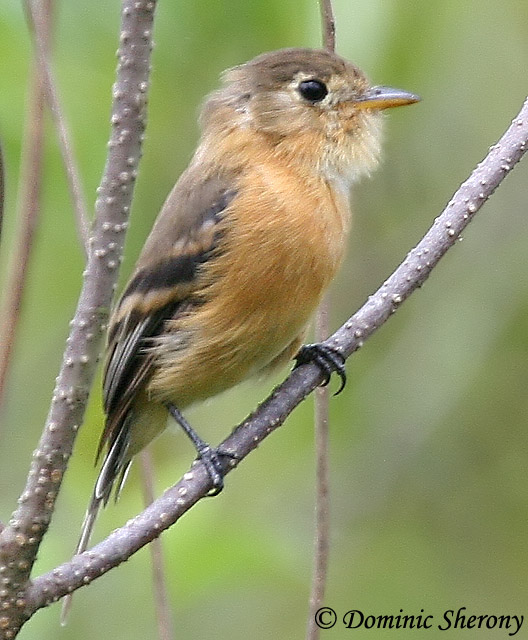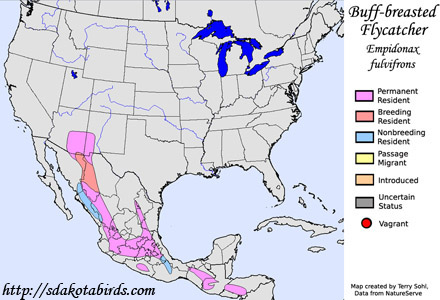| Length: 5 inches | Wingspan: 7.5 inches | Seasonality: Non-resident in South Dakota |
| ID Keys: Smallest Empidonax flycatcher, brownish-gray upperparts, buffy breast (can be worn by mid-summer), short bill | ||
 The
Buff-breasted Flycatcher is the smallest of the Empidonax flycatchers, and
one of the easier ones to identify. Their buffy breast distinguishes
them from other Empidonax species, although in some adult birds, the buffy
color isn't very apparent in worm plumage of the late summer. The
species has started to make a few appearances in southern Texas, in addition
to its normal U.S. range in far southern Arizona and New Mexico. The
species may have once been more widespread in the open pine forests of the
Southwest, before human beings arrived. They prefer pine forests with
an open grassy understory, a habitat that is maintained by regular fire.
With a human presence, natural fires are suppressed, changing the nature of
the understory.
The
Buff-breasted Flycatcher is the smallest of the Empidonax flycatchers, and
one of the easier ones to identify. Their buffy breast distinguishes
them from other Empidonax species, although in some adult birds, the buffy
color isn't very apparent in worm plumage of the late summer. The
species has started to make a few appearances in southern Texas, in addition
to its normal U.S. range in far southern Arizona and New Mexico. The
species may have once been more widespread in the open pine forests of the
Southwest, before human beings arrived. They prefer pine forests with
an open grassy understory, a habitat that is maintained by regular fire.
With a human presence, natural fires are suppressed, changing the nature of
the understory.
Habitat: Found in open pine woodlands, often in canyons with streams in the U.S. part of their range. Similar habitat is used by the species during the winter and summer months, although they will sometimes utilize lower-elevation habitats in the winter.
Diet: Feeds on insects and spiders.
Behavior: Forages by observing from a perch, and flying out to capture insects in mid-air, or by hovering and gleaning insects from the surface of the foliage or branches. They will also sometimes drop down and grab insects from the ground.
Nesting: The nest of a Buff-breasted Flycatcher is an open cup built of leaves, spider webs, grasses, and roots, with the outside often covered with moss, lichen for bits of bark. The female usually lays 3 or 4 eggs, and she alone incubates them. When the eggs hatch, both parents help to feed the young. The young fledge after about 16 days.
Song: Song of a Buff-breasted Flycatcher consists of two similar musical phrases sung back-to-back...Pi-dew, pi-DEW.
Migration: Many populations are permanent residents. Some short distance movements can occur for the winter, with some populations moving to lower elevations for the winter.
Interactive eBird Map: Click here to access an interactive map of Buff-breasted Flycatcher sightings
Similar Species: In range, most likely to be confused with Dusky Flycatcher or Hammond's Flycatcher.
Conservation Status: Populations appear to be decreasing, but they are still found over a relatively wide geographic area and are common in parts of their range. The IUCN lists the Buff-breasted Flycatcher as a species of "Least Concern".
Further Information: 1) BirdLife International - Buff-breasted Flycatcher
2) Whatbird - Buff-breasted Flycatcher
3) Audubon Guide - Buff-breasted Flycatcher
Photo Information: Photo taken by Dominic Sherony - Photo licensed under Creative Commons Attribution ShareAlike 2.0 Generic License.
| Click below for a higher-resolution map |
 |
| South Dakota Status: Non-resident in South Dakota |
Additional Buff-breasted Flycatcher Photos (coming soon!!)
